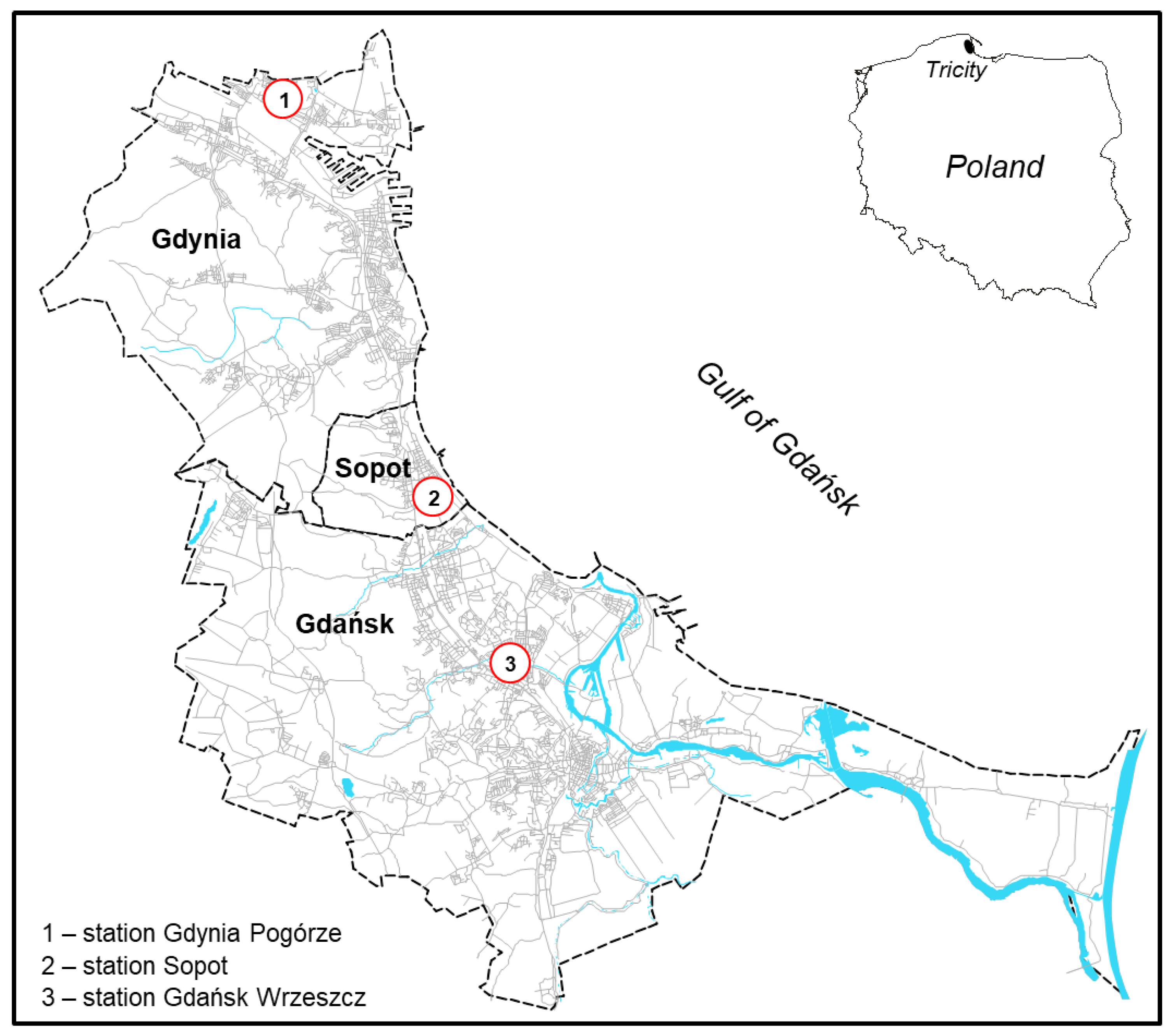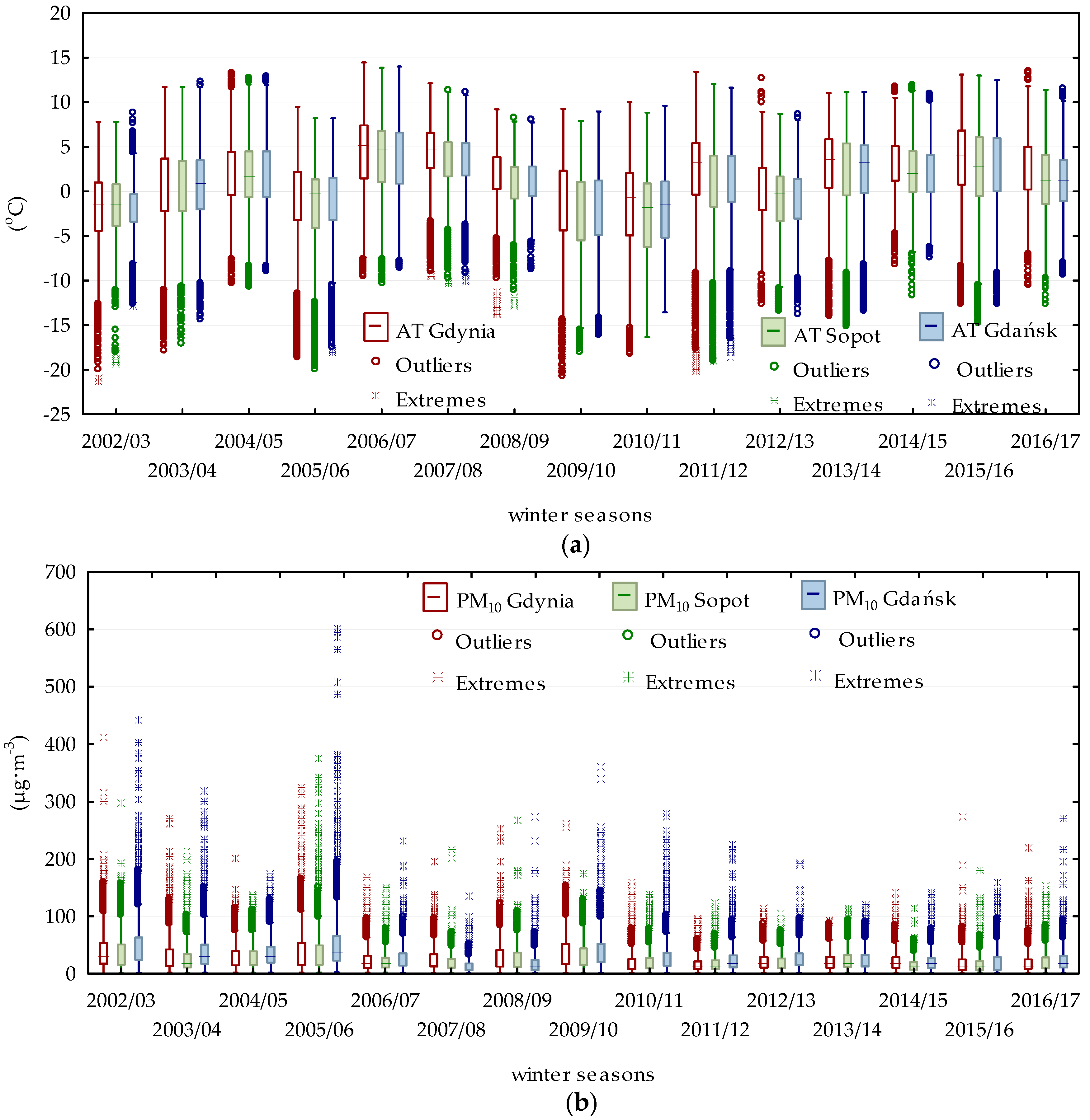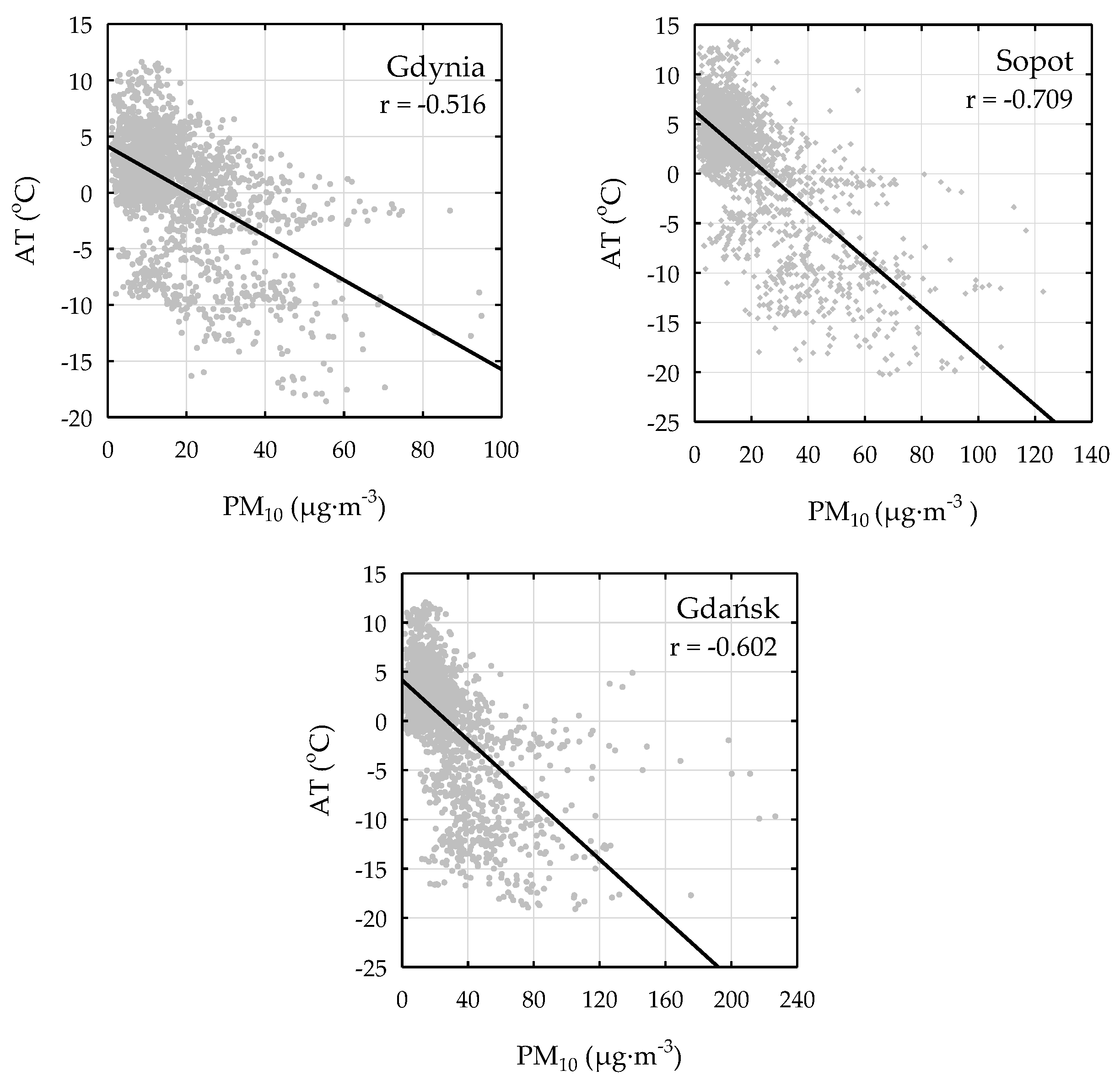Application of Artificial Neural Networks in the Prediction of PM10 Levels in the Winter Months: A Case Study in the Tricity Agglomeration, Poland
Abstract
:1. Introduction
2. Materials and Methods
2.1. Research Area
2.2. PM10 Data and Meteorological Observation
2.3. Statistical Methods
3. Results and Discussion
3.1. General Description of PM10 and Meteorology Variables
3.2. Artificial Neural Networks
4. Conclusions
Acknowledgments
Conflicts of Interest
References
- Philip, S.; Martin, R.V.; van Donkelaar, A.; Lo, J.W.-H.; Wang, Y.; Chen, D.; Zhang, L.; Kasibhatla, P.S.; Wang, S.; Zhang, Q.; et al. Global chemical composition of ambient fine particulate matter for exposure assessment. Environ. Sci. Technol. 2014, 48, 13060–13068. [Google Scholar] [CrossRef] [PubMed]
- Taiwo, A.M.; Beddows, D.C.S.; Shi, Z.; Harrison, R.M. Mass and number size distributions of particulate matter components: Comparison of an industrial site and an urban background site. Sci. Total Environ. 2014, 475, 29–38. [Google Scholar] [CrossRef] [PubMed]
- Samek, L.; Stegowski, Z.; Furman, L. Preliminary PM2.5 and PM10 fractions source apportionment complemented by statistical accuracy determination. Nukleonika 2016, 61, 75–83. [Google Scholar] [CrossRef]
- Almeida, S.M.; Pio, C.A.; Freitas, M.C.; Reis, M.A.; Trancoso, M.A. Approaching PM2.5 and PM2.5–10 source apportionment by mass balance analysis, principal component analysis and particle size distribution. Sci. Total Environ. 2006, 368, 663–674. [Google Scholar] [CrossRef] [PubMed]
- Eleftheriadis, K.; Oschenkuhn, K.M.; Lymperopoulou, T.; Karanasiou, A.; Razos, P.; Ochsenkuhn-Petropoulou, M. Influence of local and regional sources on the observed spatial and temporal variability of size resolved atmospheric aerosol mass concentrations and water-soluble species in the Athens metropolitan area. Atmos. Environ. 2014, 97, 252–261. [Google Scholar] [CrossRef]
- Majewski, G.; Rogula-Kozłowska, W. The elemental composition and origin of fine ambient particles in the largest Polish conurbation: First results from the short-term winter campaign. Theor. Appl. Climatol. 2016, 125, 79–92. [Google Scholar] [CrossRef]
- Brunekreef, B.; Holgate, S.T. Air pollution and health. Lancet 2002, 360, 1233–1242. [Google Scholar] [CrossRef]
- Kappos, A.D.; Bruckmann, P.; Eikmann, T.; Englert, N.; Heinrich, U.; Hoppe, P.; Koch, E.; Krause, G.H.M.; Kreyling, W.G.; Rauchfuss, K.; et al. Health effects of particles in ambient air. Int. J. Hyg. Environ. Health 2004, 207, 399–407. [Google Scholar] [PubMed]
- Medina, S.; Plasencia, A.; Ballester, F.; Mucke, H.G.; Schwartz, J. Apheis: Public health impact of PM10 in 19 European cities. J. Epidemiol. Commun. Health 2004, 58, 831–836. [Google Scholar] [CrossRef] [PubMed]
- Wilson, J.G.; Kingham, S.; Pearce, J.; Sturman, A.P. A review of intraurban variation in particulate air pollution: Implications for epidemiological research. Atmos. Environ. 2005, 39, 6444–6462. [Google Scholar] [CrossRef]
- Dominici, F.; Peng, R.D.; Bell, M.L.; Pham, L.; McDermott, A.; Zeger, S.L.; Samet, J.M. Fine particulate air pollution and hospital admission for cardiovascular and respiratory diseases. JAMA 2006, 295, 1127–1134. [Google Scholar] [CrossRef] [PubMed]
- Freitas, M.C.; Pacheco, A.M.G.; Verburg, T.G.; Wolterbeek, H.T. Effect of particulate matter, atmospheric gases, temperature, and humidity on respiratory and circulatory diseases’ trends in Lisbon, Portugal. Environ. Monit. Assess. 2010, 162, 113–121. [Google Scholar] [CrossRef] [PubMed]
- Shi, L.; Zanobetti, A.; Kloog, I.; Coull, B.A.; Koutrakis, P.; Melly, S.J.; Schwartz, J.D. Low-concentration PM2.5 and mortality: Estimating acute and chronic effects in a population-based study. Environ. Health Perspect. 2015, 124, 46. [Google Scholar] [CrossRef] [PubMed]
- Widziewicz, K.; Rogula-Kozłowska, W.; Loska, K.; Kociszewska, K.; Majewski, G. Health Risk Impacts of Exposure to Airborne metals and Benzo(A)Pyrene during Episodes of High PM10 Concentrations in Poland. Biomed. Environ. Sci. 2018, 31, 323–332. [Google Scholar] [CrossRef]
- Zwozdziak, A.; Gini, M.I.; Samek, L.; Rogula-Kozlowska, W.; Sowka, I.; Eleftheriadis, K. Implications of the aerosol size distribution modal structure of trace and major elements on human exposure, inhaled dose and relevance to the PM2.5 and PM10 metrics in a European pollution hotspot urban area. J. Aerosol Sci. 2017, 103, 38–52. [Google Scholar] [CrossRef]
- Lim, S.S.; Vos, T.; Flaxman, A.D.; Danaei, G.; Shibuya, K.; Adair-Rohani, H.; AlMazroa, M.A.; Amann, M.; Anderson, H.R.; Andrews, K.G.; et al. A comparative risk assessment of burden of disease and injury attributable to 67 risk factors and risk factor clusters in 21 regions, 1990–2010: A systematic analysis for the Global Burden of Disease Study 2010. Lancet 2012, 380, 2224–2260. [Google Scholar] [CrossRef]
- European Environment Agency. Air Quality in Europe—2017 Report; European Environment Agency: Copenhagen, Denmark, 2017. [Google Scholar]
- Organization for Economic Cooperation and Development. Environmental Outlook to 2050, the Consequences of Inaction. In Organisation for Economic Co-Operation and Development Publishing; Organization for Economic Cooperation and Development: Paris, France, 2012. [Google Scholar]
- Kukkonen, J.; Pohjola, M.; Sokhi, R.S.; Luhana, L.; Kitwiroon, N.; Fragkou, L.; Rantamäki, M.; Berge, E.; Ødegaard, V.; Slørdal, L.H.; et al. Analysis and evaluation of selected local-scale PM10 air pollution episodes in four European cities: Helsinki, London, Milan and Oslo. Atmos. Environ. 2005, 39, 2759–2773. [Google Scholar] [CrossRef]
- Czarnecka, M.; Nidzgorska-Lencewicz, J. Impact of weather conditions on winter and summer air quality. Int. Agrophys. 2011, 25, 7–12. [Google Scholar]
- Shahraiyni, H.T.; Sodoudi, S. Statistical Modeling Approaches for PM10 Prediction in Urban Areas; A Review of 21st-Century Studies. Atmosphere 2016, 7, 15. [Google Scholar] [CrossRef]
- Whalley, J.; Zandi, S. Particulate matter sampling techniques and data modelling methods. In Air Quality-Measurement and Modeling; INTECH: Morn Hill, UK, 2016; pp. 29–54. [Google Scholar] [CrossRef]
- Taşpınar, F. Improving artificial neural network model predictions of daily average PM10 concentrations by applying principle component analysis and implementing seasonal models. J. Air Waste Manag. Assoc. 2015, 65, 800–809. [Google Scholar] [CrossRef] [PubMed]
- Ul-Saufie, A.Z.; Yahaya, A.S.; Ramli, N.A.; Rosaida, N.; Hamid, H.A. Future daily PM10 concentrations prediction by combining regression models and feedforward backpropagation models with principle component analysis (PCA). Atmos. Environ. 2013, 77, 621–630. [Google Scholar] [CrossRef]
- Sayegh, A.S.; Munir, S.; Habeebullah, T.M. Comparing the performance of statistical models for predicting PM10 concentrations. Aerosol Air Qual. Res. 2014, 14, 653–665. [Google Scholar] [CrossRef]
- Taşpınar, F.; Bozkurt, Z. Application of artificial neural networks and regression models in the prediction of daily maximum PM10 concentration in Düzce, Turkey. Fresenius Environ. Bull. 2014, 23, 2450–2459. [Google Scholar]
- Czarnecka, M.; Nidzgorska-Lencewicz, J. Application of cluster analysis in defining the meteorological conditions shaping the variability of PM10 concentration. Annu. Set Environ. Prot. 2015, 17, 40–61. [Google Scholar]
- Nazif, A.; Mohammed, N.I.; Malakahmad, A.; Abualqumboz, M.S. Application of step wise regression analysis in predicting future particulate matter concentration episode. Water Air Soil Pollut. 2016, 227, 117. [Google Scholar] [CrossRef]
- Qiao, J.; Cai, J.; Han, H.; Cai, J. Predicting PM2.5 concentrations at a regional background station using second order self-organizing fuzzy neural network. Atmosphere 2017, 8, 10–17. [Google Scholar] [CrossRef]
- Pires, J.; Martins, F.; Sousa, S.; Alvim-Ferraz, M.; Pereira, M. Prediction of the daily mean PM10 concentrations using linear models. Am. J. Environ. Sci. 2008, 4, 445–453. [Google Scholar] [CrossRef]
- Voukantsis, D.; Karatzas, K.; Kukkonen, J.; Räsänen, T.; Karppinen, A.; Kolehmainen, M. Intercomparison of air quality data using principal component analysis, and forecasting of PM10 and PM2.5 concentrations using artificial neural networks, in Thessaloniki and Helsinki. Sci. Total Environ. 2011, 409, 1266–1276. [Google Scholar] [CrossRef] [PubMed]
- Azid, A.; Juahir, H.; Toriman, M.E.; Kamarudin, M.K.A.; Saudi, A.S.M.; Hasnam, C.N.C.; Aziz, N.A.A.; Fazureen Azaman, F.; Latif, M.T.; Zainuddin, S.F.M.; et al. Prediction of the Level of Air Pollution Using Principal Component Analysis and Artificial Neural Network Techniques: A Case Study in Malaysia. Water Air Soil Pollut. 2014, 225, 2063. [Google Scholar] [CrossRef]
- Demuzere, M.; Trigo, R.M.; Vila-Guerau de Arellano, J.; van Lipzig, N.P.M. The impact of weather and atmospheric circulation on O3 and PM10 levels at a rural mid-latitude site. Atmos. Chem. Phys. 2009, 9, 2695–2714. [Google Scholar] [CrossRef]
- İçağa, Y.; Sabah, E. Statistical analysis of air pollutants and meteorological parameters in Afyon, Turkey. Environ. Model. Assess. 2009, 14, 259–266. [Google Scholar] [CrossRef]
- Leśniok, M.; Caputa, Z. The role of atmospheric circulation in air pollution distribution in Katowice Region (Southern Poland). Int. J. Environ. Waste Manag. 2009, 4, 62–74. [Google Scholar] [CrossRef]
- Unal, Y.S.; Toros, H.; Deniz, A.; Incecik, S. Influence of meteorological factors and emission sources on spatial and temporal variations of PM10 concentrations in Istanbul metropolitan area. Atmos. Environ. 2011, 45, 5504–5513. [Google Scholar] [CrossRef]
- Nidzgorska-Lencewicz, J.; Czarnecka, M. Winter weather conditions vs. air quality in Tricity, Poland. Theor. Appl. Climatol. 2015, 119, 611–627. [Google Scholar] [CrossRef]
- Li, Y.; Chen, Q.; Zhao, H.; Wang, L.; Tao, R. Variations in PM10, PM2.5 and PM1.0 in an urban area of the Sichuan Basin and their relation to meteorological factors. Atmosphere 2015, 6, 150–163. [Google Scholar] [CrossRef]
- Czarnecka, M.; Nidzgorska-Lencewicz, J. The impact of thermal inversion on the variability of PM10 concentration in winter seasons in Tricity. Environ. Prot. Eng. 2017, 43, 157–172. [Google Scholar]
- Czernecki, B.; Półrolniczak, M.; Leszek Kolendowicz, L.; Marosz, M.; Kendzierski, S.; Pilguj, N. Influence of the atmospheric conditions on PM10 concentrations in Poznań, Poland. J. Atmos. Chem. 2017, 74, 115–139. [Google Scholar] [CrossRef]
- Reizer, M.; Juda-Rezler, K. Explaining the high PM10 concentrations observed in Polish urban areas. Air Qual. Atmos. Health 2016, 9, 517–531. [Google Scholar] [CrossRef] [PubMed]
- Central Statistical Office. Available online: http://stat.gov.pl (accessed on 20 February 2018).
- Państwowy Monitoring Środowiska, Inspekcja Ochrony Środowiska. The Air Quality Assesment in Zones in Poland for 2016, Warsaw 2017 (in Polish). Available online: https://powietrze.gios.gov.pl/pjp/documents/download/102460 (accessed on 20 March 2018).
- Directive CAFÉ. Available online: https://eur-lex.europa.eu/legal-content/PL/TXT/?uri=CELEX%3A32008L0050 (accessed on 20 February 2018).
- Grivas, G.; Chaloulakou, A. Artificial neural network models for prediction of PM10 hourly concentrations, in the Greater Area of Athens, Greece. Atmos. Environ. 2006, 40, 1216–1229. [Google Scholar] [CrossRef]
- Yan Chan, K.; Jian, L. Identification of significant factors for air pollution levels using a neural network based knowledge discovery system. Neurocomputing 2013, 99, 564–569. [Google Scholar] [CrossRef]
- Hanna, S.; Chang, J. Acceptance criteria for urban dispersion model evaluation. Meteorol. Atmos. Phys. 2012, 116, 133–146. [Google Scholar] [CrossRef]
- Juda-Rezler, K.; Reizer, M.; Oudinet, J.P. Determination and analysis of PM10 source apportionment during episodes of air pollution in Central Eastern European urban areas: The case of wintertime 2006. Atmos. Environ. 2011, 45, 6557–6566. [Google Scholar] [CrossRef]
- Jędruszkiewicz, J.; Czernecki, B.; Marosz, M. The variability of PM10 and PM2.5 concentrations in selected Polish agglomerations: The role of meteorological conditions, 2006–2016. Int. J. Environ. Health Res. 2017, 27, 441–462. [Google Scholar] [CrossRef] [PubMed]
- Rawicki, K.; Czarnecka, M.; Nidzgorska-Lencewicz, J. Regions of pollution with particulate matter in Poland. E3S Web Conf. 2018, 28, 01025. [Google Scholar] [CrossRef]
- Lauret, P.; Heymes, F.; Forestierb, S.; Laurent Aprina, L.; Peyb, A.; Perrin, M. Forecasting powder dispersion in a complex environment using Artificial Neural Networks. Process Saf. Environ. Prot. 2017, 110, 71–76. [Google Scholar] [CrossRef]
- Hooyberghs, J.; Mensink, C.; Dumont, G.; Fierens, F.; Brasseur, O. A neural network forecast for daily average PM10 concentrations in Belgium. Atmos. Environ. 2005, 39, 3279–3289. [Google Scholar] [CrossRef]





| Variable | Mean | Min | Max | SD |
|---|---|---|---|---|
| Gdynia Pogórze | ||||
| PM10 (μg·m−3) | 26.81 | 1.00 | 324.35 | 24.59 |
| AT (°C) | 1.04 | −18.55 | 14.00 | 4.46 |
| RH (%) | 80.86 | 30.20 | 100.00 | 11.29 |
| PRES (hPa) | 1006.67 | 960.10 | 1047.95 | 13.68 |
| WS (m·s−1) | 1.92 | 0.02 | 8.55 | 1.25 |
| Sopot | ||||
| PM10 (μg·m−3) | 25.13 | 1.00 | 375.7 | 23.39 |
| AT (°C) | 1.26 | −21.40 | 14.45 | 5.00 |
| RH (%) | 82.27 | 30.37 | 100.00 | 10.09 |
| PRES (hPa) | 1008.77 | 964.10 | 1045.60 | 12.30 |
| WS (m·s−1) | 1.92 | 0.03 | 8.00 | 1.14 |
| Gdańsk Wrzeszcz | ||||
| PM10 (μg·m−3) | 31.10 | 1.00 | 599.75 | 32.85 |
| AT (°C) | 0.48 | −19.95 | 13.85 | 5.03 |
| RH (%) | 82.38 | 31.90 | 100.00 | 9.66 |
| PRES (hPa) | 1011.40 | 962.80 | 1043.25 | 12.32 |
| WS (m·s−1) | 2.16 | 0.03 | 8.95 | 1.24 |
| ANN Models | Topology | Activation Function for Hidden Layer | Activation Function for Output Layer | IA | FB | RMSE | R2 | IA | FB | RMSE | R2 | IA | FB | RMSE | R2 |
|---|---|---|---|---|---|---|---|---|---|---|---|---|---|---|---|
| Train | Validation | Test | |||||||||||||
| Gdynia Pogórze | |||||||||||||||
| PM10_h+1 | 5-8-1 | Logistic | Exponential | 0.944 | 0.00 | 10.91 | 0.805 | 0.939 | 0.00 | 11.09 | 0.803 | 0.934 | −0.02 | 10.80 | 0.783 |
| PM10_h+2 | 5-7-1 | Logistic | Identity | 0.901 | 0.00 | 13.81 | 0.686 | 0.889 | 0.01 | 13.72 | 0.706 | 0.888 | 0.00 | 12.91 | 0.673 |
| PM10_h+3 | 5-11-1 | Logistic | Exponential | 0.866 | 0.00 | 15.31 | 0.611 | 0.848 | 0.00 | 15.09 | 0.634 | 0.824 | 0.00 | 15.16 | 0.574 |
| PM10_h+4 | 5-9-1 | Logistic | Tanh | 0.837 | 0.00 | 16.52 | 0.552 | 0.786 | 0.00 | 15.94 | 0.553 | 0.806 | 0.00 | 16.33 | 0.540 |
| PM10_h+5 | 5-10-1 | Exponential | Tanh | 0.811 | 0.00 | 17.39 | 0.504 | 0.751 | 0.00 | 16.65 | 0.510 | 0.757 | 0.00 | 17.50 | 0.482 |
| PM10_h+6 | 5-10-1 | Tanh | Exponential | 0.802 | 0.00 | 17.45 | 0.487 | 0.724 | 0.00 | 17.76 | 0.499 | 0.693 | 0.02 | 18.15 | 0.452 |
| Sopot | |||||||||||||||
| PM10_h+1 | 5-10-1 | Tanh | Identity | 0.956 | 0.00 | 9.32 | 0.844 | 0.951 | 0.00 | 9.42 | 0.832 | 0.957 | 0.00 | 8.80 | 0.848 |
| PM10_h+2 | 5-8-1 | Tanh | Tanh | 0.924 | 0.00 | 11.78 | 0.749 | 0.909 | 0.00 | 11.94 | 0.721 | 0.921 | 0.00 | 11.26 | 0.758 |
| PM10_h+3 | 5-10-1 | Tanh | Exponential | 0.899 | 0.00 | 13.14 | 0.685 | 0.876 | −0.01 | 12.98 | 0.655 | 0.881 | 0.02 | 13.12 | 0.690 |
| PM10_h+4 | 5-7-1 | Logistic | Tanh | 0.876 | 0.00 | 14.19 | 0.632 | 0.847 | 0.00 | 14.02 | 0.600 | 0.855 | 0.01 | 13.97 | 0.643 |
| PM10_h+5 | 5-11-1 | Logistic | Exponential | 0.860 | 0.00 | 14.75 | 0.597 | 0.811 | +0.02 | 15.02 | 0.550 | 0.816 | 0.02 | 15.00 | 0.595 |
| PM10_h+6 | 5-11-1 | Tanh | Exponential | 0.846 | 0.00 | 14.97 | 0.565 | 0.816 | 0.04 | 15.36 | 0.532 | 0.811 | 0.02 | 14.90 | 0.578 |
| Gdańsk Wrzeszcz | |||||||||||||||
| PM10_h+1 | 5-6-1 | Tanh | Exponential | 0.950 | 0.00 | 13.41 | 0.825 | 0.953 | 0.00 | 13.90 | 0.842 | 0.954 | 0.00 | 13.37 | 0.846 |
| PM10_h+2 | 5-6-1 | Exponential | Identity | 0.902 | 0.00 | 17.85 | 0.694 | 0.906 | 0.00 | 17.97 | 0.732 | 0.906 | 0.00 | 17.33 | 0.730 |
| PM10_h+3 | 5-6-1 | Exponential | Logistic | 0.866 | 0.00 | 20.18 | 0.616 | 0.850 | 0.00 | 21.12 | 0.632 | 0.858 | 0.00 | 20.02 | 0.639 |
| PM10_h+4 | 5-9-1 | Exponential | Logistic | 0.833 | 0.00 | 22.02 | 0.551 | 0.820 | 0.00 | 21.93 | 0.562 | 0.828 | 0.00 | 21.04 | 0.572 |
| PM10_h+5 | 5-10-1 | Tanh | Tanh | 0.829 | 0.00 | 22.20 | 0.540 | 0.796 | 0.01 | 23.62 | 0.499 | 0.805 | 0.00 | 22.19 | 0.538 |
| PM10_h+6 | 5-9-1 | Tanh | Exponential | 0.812 | 0.00 | 22.82 | 0.507 | 0.761 | 0.02 | 23.93 | 0.483 | 0.765 | 0.01 | 23.56 | 0.504 |
© 2018 by the author. Licensee MDPI, Basel, Switzerland. This article is an open access article distributed under the terms and conditions of the Creative Commons Attribution (CC BY) license (http://creativecommons.org/licenses/by/4.0/).
Share and Cite
Nidzgorska-Lencewicz, J. Application of Artificial Neural Networks in the Prediction of PM10 Levels in the Winter Months: A Case Study in the Tricity Agglomeration, Poland. Atmosphere 2018, 9, 203. https://doi.org/10.3390/atmos9060203
Nidzgorska-Lencewicz J. Application of Artificial Neural Networks in the Prediction of PM10 Levels in the Winter Months: A Case Study in the Tricity Agglomeration, Poland. Atmosphere. 2018; 9(6):203. https://doi.org/10.3390/atmos9060203
Chicago/Turabian StyleNidzgorska-Lencewicz, Jadwiga. 2018. "Application of Artificial Neural Networks in the Prediction of PM10 Levels in the Winter Months: A Case Study in the Tricity Agglomeration, Poland" Atmosphere 9, no. 6: 203. https://doi.org/10.3390/atmos9060203




